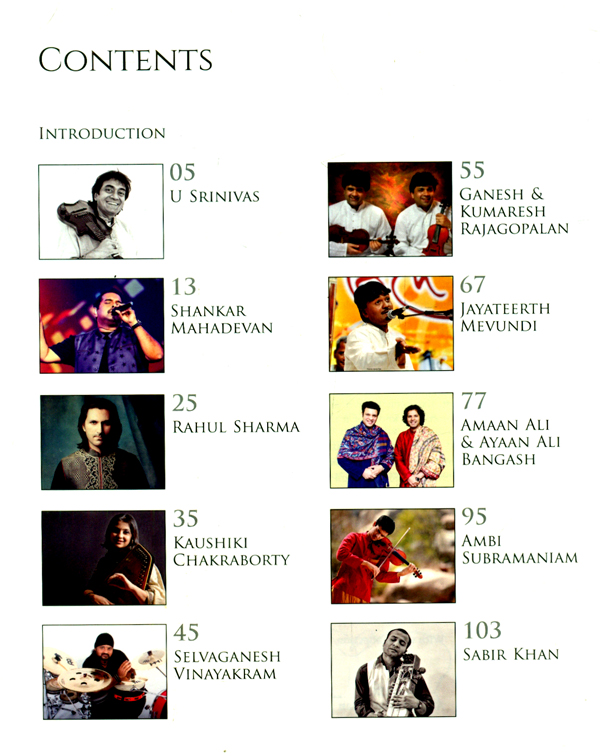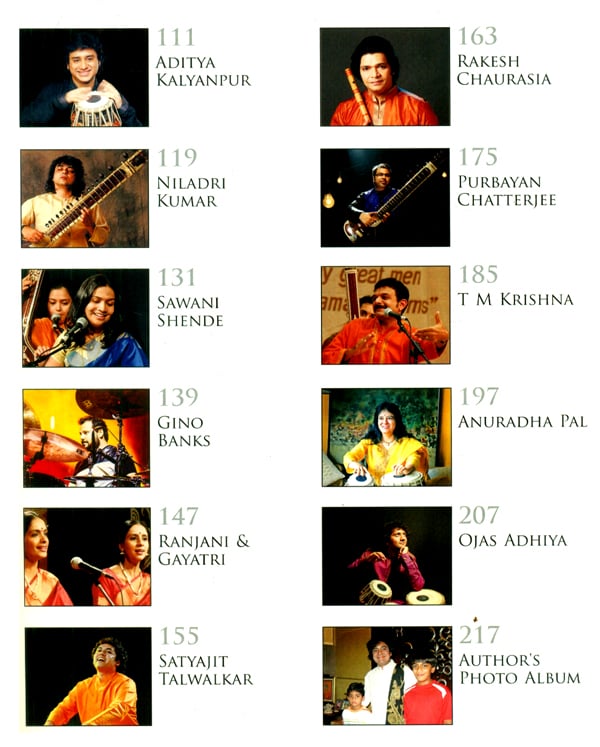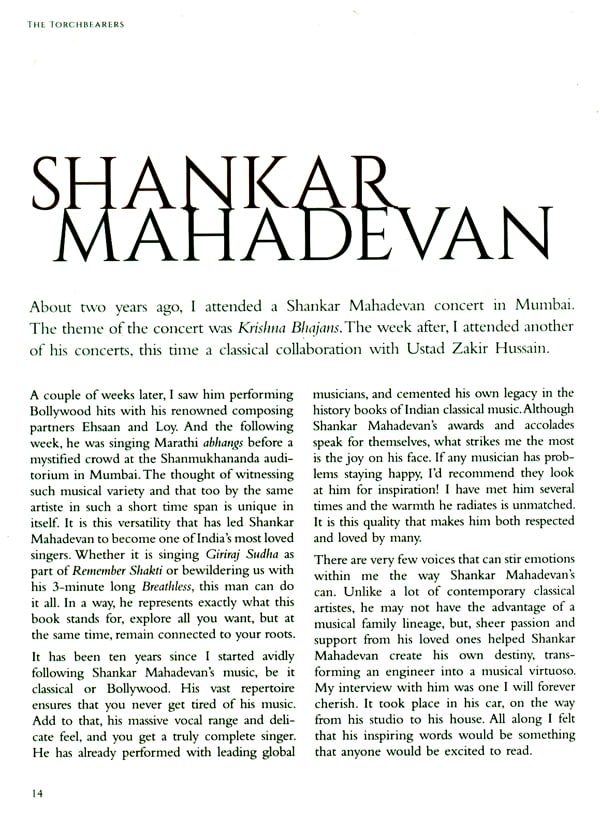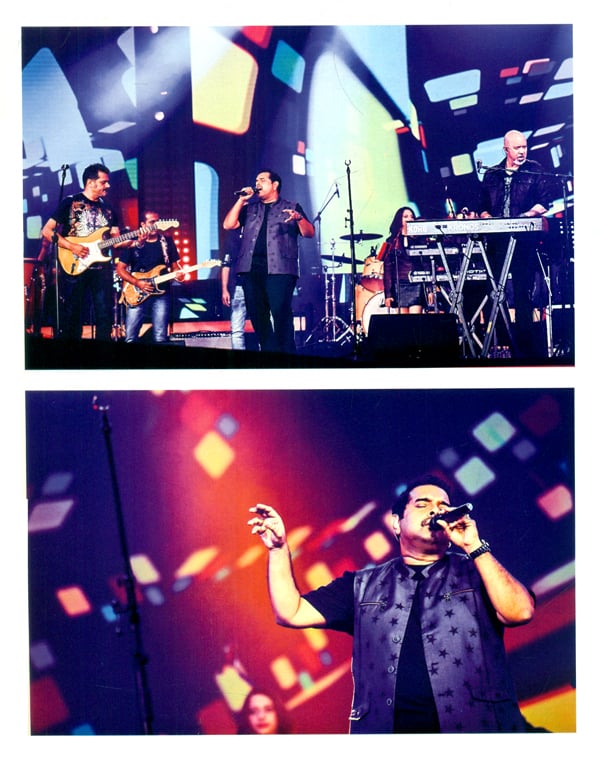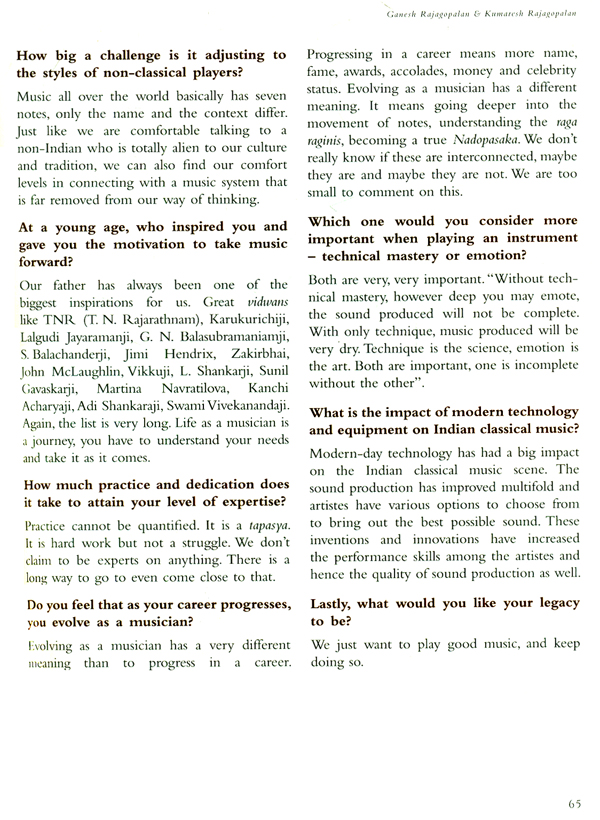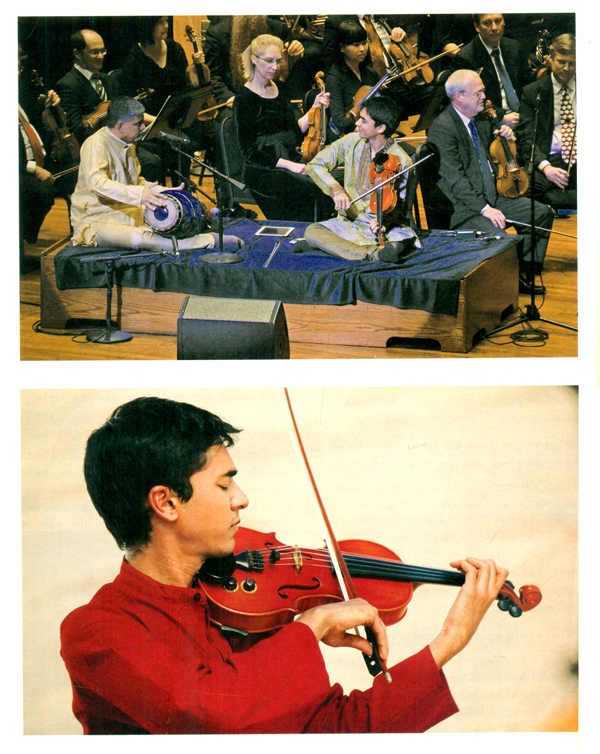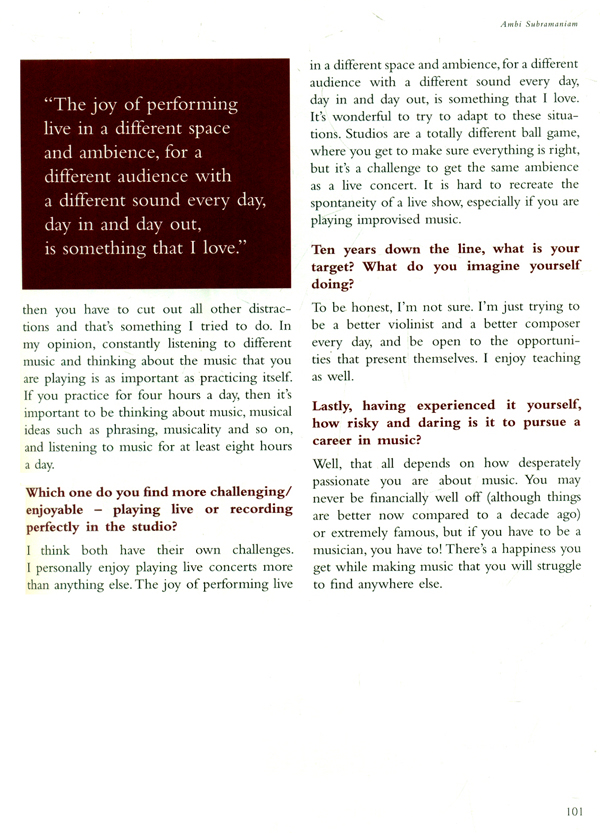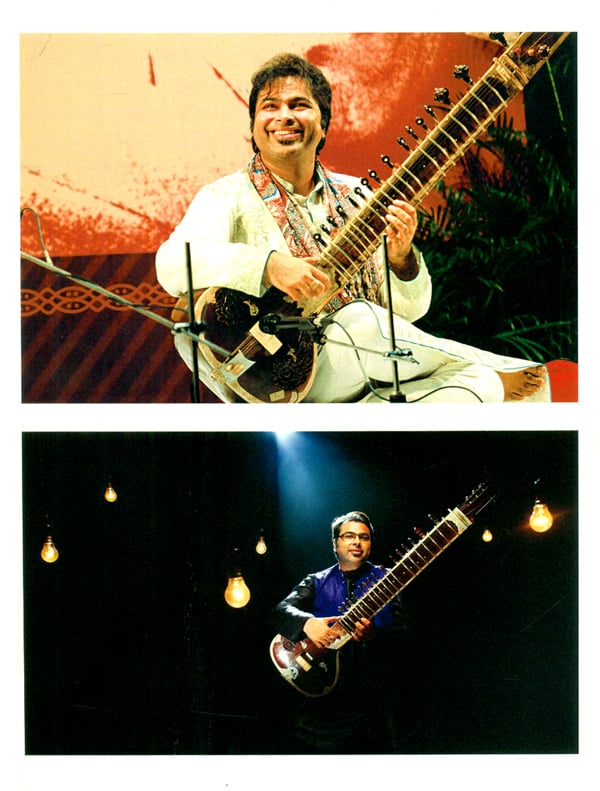
The Torchbearers (Keep the Flame of Indian Classical Music Alive)
Book Specification
| Item Code: | NAW335 |
| Author: | Harsh Meswani |
| Publisher: | Vakils, Feffer and Simons Pvt. Ltd. |
| Language: | English |
| Edition: | 2016 |
| ISBN: | 9788184621365 |
| Pages: | 238 (Throughout Colored Illustrations) |
| Cover: | HARDCOVER |
| Other Details | 12.00 X 9.00 inch |
| Weight | 1.32 kg |
Book Description
The Torchbearers is a tribute to the extraordinary talent and genius of our master Musicians of today who are rich music tradition of India. Populated by a plethora of different voices and experiences, the Narrative will illuminate the readers about this rich art from and eccourage them to keep the flames of Indian Classical music alive.
Born in 1998, Harsh Meswani is a high school student, residing in Mumbai, India. He is a budding young musician, born in a business family.
He has two music albums to his credit. The first is a cover album named Timless and the other an instrumental album consisting entirely of his own composition, named Trial of Thought.
At an early age, his parents exposed him to indian classical music and it is this ecpousure that led Harsh to cultivate his love for music.
He is deeply passionate about the cause of promoting Indian classical music and this book is one of the initiatives towards this cause.
He has also started a website Indian Concert Guide, to provide Information about music events taking place in the city.
He has two music albums to his credit. His first album, is a cover album named Timeless. His second album named Tiail of Thought is an instrumental album consisting entirely of his own compositions.
At an early age, his parents exposed him to Indian classical music and it is this exposure that led Harsh to cultivate his love for music. He is deeply passionate about the cause of promoting Indian classical music and this book is one of his initiatives towards this cause.
He has launched Indian Concert Guide, a website which aims at building an online community of musicians and music lovers. It provides accurate information about various Indian classical music events taking place in the city.
Harsh is a nature lover who enjoys sports and the outdoors. He plays tennis at a competitive level and is also an avid skiier.
I was curious when Harsh asked me to write a few words about this book he was writing. The subject, though near and dear to me personally, appeared to be at the opposite end of the world that he occupies. He belongs to one of the most successful industrial houses of India and is being groomed to be one of the pillars of the family’s business.
In order to tackle a subject that goes directly to the root of our culture, one must have a certain amount of understanding and knowledge of that art form and also the protocols that it invokes. I have come to the belief that Harsh has the tools necessary to embark on the journey of musical discoveries. He owes a lot to his parents Bijal and Hital who took great care that all aspects of art and culture were made available to him and that a deep respect for our tradition was planted in him.
It is vital that our future generations understand the importance of preserving and nurturing our tradition and culture because that is at the core of who we are and it establishes our identity and place in the world. In this book, Harsh has attempted to bring to light the bench strength of Indian music. He strives to show the reader that our music does not stop at a Pandit Ravi Shankar performance or a Pandit Jasraj Haveli Sangeet or a Kishori Amonkar’s Maliro Pranaam. He in fact appeals to his contemporaries to discover the extraordinary talent and genius of the young masters of today who will be the flag bearers of this great music tradition in the near future. It was as a sceptic that I started to read the opening paragraphs of Harsh’s book. I was surprised to see how passionate and concerned he was about conveying with clarity, honesty and proper respect, his conversations with the young maestros. I am happy to say that this attempt of Harsh is a success. I hope that he reaches the youth of our country and enlightens them with the wonders of this great musical form.
My parents exposed me to Indian classical music at an early age for which I consider myself fortunate. Over the years I have come to like Indian classical music immensely and have devel- oped tremendous respect for both, the artiste and the art form of our country. The art form is truly unique as it covers various styles of music from Carnatic to Hindustani, from instrumental to vocal, and also allows improvisation which makes this music compatible with even jazz and Western instruments to produce fusion music.
Today, this art form faces stiff competition from other forms of music which are increasingly becoming more commercial in our country and I strongly feel that not enough is being done to preserve this art form and our rich culture and heritage. The legends of Indian classical music who have made India proud and who represent India and our music on the world centre stage, like Ustad Zakir Hussain and many others have done a tremendous job in nurturing the next generation of artistes and passing on the legacy seamlessly to them. But, unless the youth of this country takes an active role in embracing and adopting this art form, we will fall short in our duty in giving Indian classical music its rightful place. Hence, I thought of spreading awareness amongst the youth and that’s how the idea of the book was born.
My initial thought was to describe the richness of Indian classical music to the readers and flooding them with details, but instead I thought it would be more appropriate if I could feature today’s artistes and connect them to the youth i.e. connecting the art and the artiste to the reader. I thought of doing this in more of a conversational style in a question — answer format where I could capture insights and viewpoints of the various artistes and how they became successful, how this art form has a lot to offer and what needs to be done to preserve it.
I bounced this idea off Ustad Zakir Hussain who immensely motivated me and encouraged me to develop the concept further and cover the present day musicians in my book. I quickly compiled a list of musicians I intended featuring. The list was very long and it would have taken me a lifetime to complete the book if I were to cover each one of them. So I came up with a short list of representative musicians who I have aptly called — The Torchbearers.
For me personally, writing this book has been a fulfilling and an enriching experience and I sincerely hope this book has an impact on our society and the youth, in particular, and motivates them to appreciate our art form and actively support and help in preserving and enhancing it further.
It was ten years ago I think, when I was sitting in the front row of the Shanmukhanand Auditorium, a performing arts center in central Mumbai. I vividly remember the scene; 2500 heads staring in disbelief at the stage, where a magical phenomenon was taking place. On the mandolin was Maestro U Srinivas, electrifying the atmosphere with unparalleled speed and dexterity. V Selvaganesh was using his tiny kanjira to generate the sound of an entire drum kit. Shankar Mahadevan’s vocal finesse filled the room with an earsplitting, yet enchanting vibe. In the center, Ustad Zakir Hussain made playing the tabla seem as easy as tying a knot. At the time, I didn’t know how blessed I was to witness four musicians of that caliber creating what I would call the most melodious cacophony.
That concert was just one of many I attended throughout my childhood. I still faintly remember those nights as a toddler, when I would be ready to sleep in my mother’s arms while the wizardry unfolded before me. At the time, I had no idea who these musicians were; in fact, I had no clue what music was! However, I gradually became accustomed to the sound, and developed a taste for Indian classical music. And after fifteen years of listening to this rich art form, I know how important it is to be exposed. My appreciation for music gradually translated into playing an instrument. Being a proficient keyboardist myself,I| know the countless hours that go into achieving even my level of expertise, let alone becoming a classical maestro! I have immense appreciation and respect for the dedication and practice required to pursue such a career. Furthermore, I find that our art form has unparalleled diversity. The sheer variety of instruments, and the fact that all instruments are compatible with one another makes both Hindustani and Carnatic music truly unique. Our music can even adjust to Western jazz and fusion! As Indians, we should also be proud of the fact that our music encourages improvisation, making the art form richer and more spontaneous. However, despite all this, I believe that Indian classical music does not get the recognition it deserves. I don’t think it’s fair that commercial artistes hog the limelight, while born geniuses are not as celebrated. A common phrase goes, "a pop musician plays 5 chords for 5000 people, while a classical musician plays 5000 chords for 5 people".
While this statement is exaggerated, it does hold some truth. Few people appreciate the 400 hours of practice required to compose four minutes of music. I began to question: do we really recognize the fact that we have inherited such a rich art form? Is the society conscious of the fact, all of us as Indians need to play our responsible role in preservation of Indian classical music?
If we are to revive this art form, and start an Indian classical renaissance, we must ensure that the younger generation is exposed from the start. They are the ones who can carry it forward, and take it to newer heights. As a student, I can positively say that in my peer group, I am yet to meet a person who has a sound understanding of Indian classical music. I find it unbelievable that despite coming from such a culturally vibrant country, most of us remain woefully ignorant towards our heritage. It’s disheartening to see that the vast majority is either unaware, or too "cool" to appreciate classical music. I have travelled almost all over Europe and most of Asia, and I am yet to see a society disinterested in preserving their own arts and traditions. I fail to fathom why something so pure, and so inherent to this country is not a part of our national identity. Now, it doesn’t take a genius to figure out why the younger generation lacks interest. It 1s completely unfair to blame children for their own lack of exposure. Commercialization of music and marketing has led to a heavy prejudice in favour of the Western world. It is natural that a 21st century child would be inclined towards what he hears on the radio. I am no different. My favourite genre of music is rock; my all time favourite bands include Pink Floyd, The Doors and Led Zeppelin. Even the music I play on keyboards is centered on rock, ambient and lounge music. But despite being a passionate rocker, I have never veered away from my roots. I consider myself just as lucky to have heard Pandit Ravi Shankar as Jimmy Page, Ustad Zakir Hussain as Neil Peart, and Pandit Shivkumar Sharma as Rick Wakeman. There is absolutely nothing wrong in taking pleasure from commercial music, as long as you have an equally strong bond with your roots.
Classical music needs to penetrate much deeper into the Indian audience for it to sustain and enhance the popularity it has achieved. Therefore, I made a conscious decision to do everything I can within my capacity to make a difference. When I see an artiste who puts his heart and soul into what he does not always achieving popularity amongst the youth, I feel pain. I feel a desire to popularize his rich music to the extent I can. And this desire is precisely what inspired me to write this book.
Ustad Zakir Hussain, Pandit Shivkumar Sharma, Ustad Amjad Ali Khan, Pandit Hariprasad Chaurasia and other living legends have played a stellar role in encouraging the next generation of musicians, mentoring them and at the same time seamlessly passing on the legacy to them. When I presented my idea to Ustad Zakirji, he not only warmly encouraged me but also advised me to include artistes from the present generation. I enforced the idea and made a list of musi- cians covering various instruments in both Hindustani and Carnatic music.
The list was so long that it would have taken me a lifetime to cover them all! 1 apologize to all the musicians I would have loved to cover, but could not due to time constraints. The artistes in this book are already established, but have several decades of musical magic left in them. Therefore, they are aptly The Torchbearers.
When I first embarked upon this journey, it seemed like a daunting task. I must admit, I did find it difficult to formulate a clear plan to support my cause. But as the number of mesmerizing concerts I attended grew, so did my desire. I could have easily undertaken the laborious task of gathering information on these musicians and compiling it all into a book. But instead I thought it more appropriate to connect the artistes with the audience. I decided that the best way to give these musicians their own recognition would be by featuring their own thoughts and opinions. The public needs to hear their voice. Fortunately, | had access through my parents to most of the musicians I intended to feature. As a result, I planned to conduct an interview with each artiste. The first artiste I interviewed was mandolin legend U Srinivas, back in December 2013 at a Mumbai hotel. I wasn’t exactly nervous, as he was a close family friend, but I did feel the usual starting anxiety. The interview went well, and provided me with the confidence to interview the next few artistes. But my increasing workload as a student surprisingly made me reconsider the idea of writing this book. However, the pain I felt with U Srinivas’ tragic death the following year instilled a new fire within me. I felt a certain responsibility to carry forward his legacy, and fulfill his desire to promote the music he loved. In one sense, this book is a tribute to his ever- lasting aura of greatness.
Anyway, I interviewed all other artistes periodically over the next two years. Had I not been passionate about the cause, it would have seemed like a burden on top of my academic and sporting schedule. It really was a "challenging pleasure" to adapt to different speaking styles, and get exposure to various viewpoints It sure was hard work, but the satisfaction of getting things done far outweighed the effort put in.
Personally, over the last few years, this book has brought out multiple facets of my identity. Amidst a competitive academic environment, it has been a bit of a refuge for me, as it involves no expectations other than my own. Along with my tennis and music, it is something I have undertaken purely out of choice, not compulsion. Therefore, I sincerely hope that this book inspires you to keep the ship of Indian music sailing. That it instills within you a fire to support those who practice it. That it urges you to help expose these hidden treasures to our talented youth. I hope, that you too join me in this quest to keep our culture alive.
